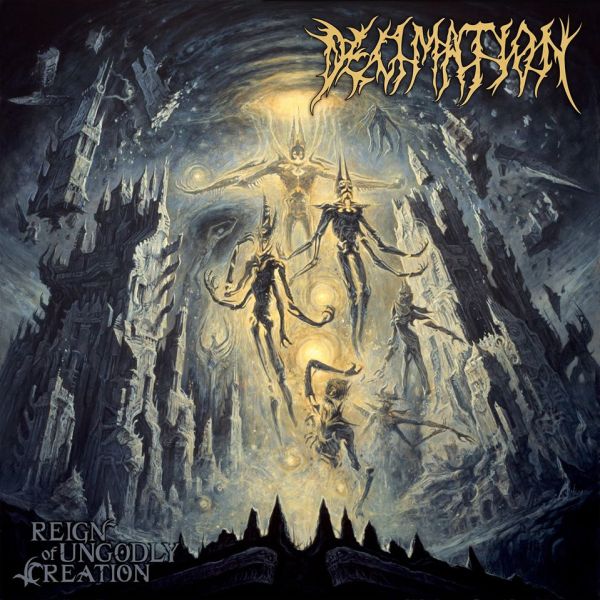Deathcore relies on trope to the point where the style becomes almost all convention with little variation within. Joining other styles like rap and techno, it reduces itself to minor deviations from a norm and so the difference between bands, albums and songs becomes less important than currency.
Decimation attempt to restore deathcore with many of the stylistic methods of later percussive death metal, specifically Suffocation Pierced From Within, and are remarkably successful in doing so but because of their extensive reliance on deathcore passages may not make the threshold for many death metal listeners. When looking through history, we see deathcore arising from the Cannibal Corpse axis where vocals lead the music and guitars exist to blat out rhythmically hook-centric riffs in coordination with drums but in support of vocal rhythms.
Decimation upgrade this to giving the guitars more leeway at the ends of phrases and between verses, where the band use phrasal riffing and open strumming to generate interest. They even write in melodic lead riffing over high-speed strumming in the way Suffocation would, which infuses these songs with a new energy but will probably offend deathcore purists. If you can imagine a hip-hop troupe who broke every other phrase to play full-on bebop, the effect is similar here in that it makes return to the deathcore that much more jarring but puts into play enough for the ears to listen to that the deathcore parts become more like rhythm comping to build up for the sweetness. Deathcore fans will note that the characteristic lack of variation in technique and approach to rhythm is consistent on the deathcore passages.
Where Decimation excels is in assembling songs around an idea despite surrounding it with a riff salad. These songs sound more composed than your average deathcore song in that they have a center and changing layout to reflect what that is, but less “composed” in that unlike classic deathcore they do not attempt to create a rhythm groove and ride it, alternating with a chorus, into the ground. Bass-intense vocals fall into cadence with guitar during verses, but range free for fills and choruses, allowing the range and texture of vocals to expand. Drums adopt the overactive style of post-Suffocation deathcore but keep an emphasis on varied internal rhythm to produce expectation rather than sheer repetition and breakdown as both techno and deathcore tend to do.
Reign of Ungodly Creation will split death metal purists. If you could listen to Cannibal Corpse alongside Suffocation and Kataklysm, this 37-minute diatribe will appeal and seem to expand on those conventions. If like many you preferred death metal before it started imitating post-hardcore, there may be too much deathcore in here for you. This perspective is entirely understandable, as the deathcore portions of this album use a few common forms in many variations, where the death metal segments vary more widely in form. It is more infectiously rhythmic and disciplined than most deathcore and so could well inject some needed life into that flagging genre.
Tags: death metal, deathcore, decimation



I’m not so sure that these guys play deathcore. Deathcore is just metalcore with downtuned strings, faster beats, and lower vocals; the differences are cosmetic, not mechanic or structural.
Consider some of the main mechanics of a metalcore song:
1) Jumping from section to section with more emphasis on abrupt shifts (in tempo, melody, whatever) than continuity.
2) Balancing guitar work between two extremes (emphasis on rhythm with a loss in melodic power versus emphasis on melody with a loss in rhythmic power).
3) Vocals able to take the role of primary percussive lead or primary melodic lead, and shift from one to the other.
Now, this song by Decimation does not show a tendency toward mechanic 1; in fact the guitar lines are given a lot of leeway to snake around while the drums (which sound like shit but are played well) blur all the disparate melodic tangents together, making you pay attention to both at the same time. Another feature that provides continuity is the vocal pattern that often trails syllables across a handful of melodic shifts. This is a not-very-death-metal way of tying up guitar phrases that don’t compliment one another, and is a mark of lazy metalcore writing; mechanic 3.
Finally, mechanic 2 is actually avoided and instead the death metal approach to guitar is keenly observed; using choppy muted notes as percussive blasts along with skittering and thrashing melodies to build phrases. The problem is that the phrases themselves are just not very good, which is why the guitarist can’t repeat them more than a couple of times; otherwise people would start to realize that the phrase is a bunch of mumbo-jumbo that is merely unexpected, not emotive.
So what we have here is not deathcore, but poorly-executed death metal. The good news is that they aren’t enmired in the metalcore style of writing. They are close to the edge, though, and if they reign in those tendencies, they could probably make some good (but not old-fashioned) death metal.
I don’t think it’s poorly-executed. Rather, I think it’s a stylistic shift. Notice the leading vocal lines coupled with a tendency for riffs to break, plus the conventions of post-Cerrito/Smith Suffocation.
I notice. A bunch of unrelated riffs slapped together means poorly-executed metal. You can call it a stylistic shift but that just means they are playing sucky death metal.
Pierced From Within was still good but bands should be focusing on Suffocation’s infusion of new techniques into death metal, rather than focusing on the new techniques without the context of death metal (the post-PFW albums). The latter is the focus of Decimation; technique alone, proteins thrashing around in a soup, unable to join up and develop something more complex because none of the proteins share similar functions; just moving parts, just clockwork. Old Suffocation used that same clockwork to build battle machines.